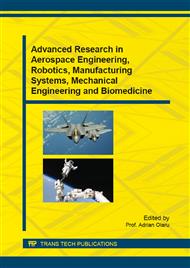[1]
J. Huddleston, A. Alaiti, D. Goldvasser, D. Scarborough, A. Freiberg, H. Rubash, H. Malchau, W. Harris, D. Krebs, in: Ambulatory measurement of knee motion and physical activity: preliminary evaluation of a smart activity monitor, Journal NeuroEng. Rehabil. 3 (2006).
DOI: 10.1186/1743-0003-3-21
Google Scholar
[2]
Godfrey, R. Conway, D. Meagher, G. ÓLaighin, in: Direct measurement of human movement by accelerometry, Medical Engineering & Physics 30 (2008).
DOI: 10.1016/j.medengphy.2008.09.005
Google Scholar
[3]
H. L. Su, D. W. Zhang, in: Study on Error Compensation of Human Motion Analysis System, Applied Mechanics and Materials, Vols. 48-49, pp.1149-1153, Feb. (2011).
DOI: 10.4028/www.scientific.net/amm.48-49.1149
Google Scholar
[4]
S. Haldeman, D. Kopansky-Giles, E. L. Hurwitz, D. Hoy, in: Advancements in the Management of Spine Disorders, Best Practice & Research Clinical Rheumatology 26 (2012).
DOI: 10.1016/j.berh.2012.03.006
Google Scholar
[5]
I. Raso, R. Hervás, J. Bravo, in: m-Physio: personalized accelerometer-based physical rehabilitation platform, in: Proc. Fourth Int. Conf. Mobile Ubiquitous Computing, Systems, Services and Technologies, Florence, Italy, 25–30October (2010).
Google Scholar
[6]
G. Y. Shi, Y. X. Zou, W. J. Li, Y. F. Jin, P. Guan, in: Towards Multi-Classification of Human Motions Using Micro IMU and SVM Training Process, Advanced Materials Research, Vols. 60-61, pp.189-193, Jan. (2009).
DOI: 10.4028/www.scientific.net/amr.60-61.189
Google Scholar
[7]
P.E. Taylor, G.J.M. Almeida, T. Kanade, J.K. Hodgins, in: Classifying human motion quality for knee osteoarthritis using accelerometers, in: Proc. 32nd Annual Int. Conf. IEEE Engineering in Medicine and Biology Society, Buenos Aires, Argentina, 31 August–4 September (2010).
DOI: 10.1109/iembs.2010.5627665
Google Scholar
[8]
D. González-Ortega, F.J. Díaz-Pernas, M. Martínez-Zarzuela,M. Antón-Rodríguez, in: A Kinect-based system for cognitive rehabilitation exercises monitoring, Comput. Meth. Prog. Bio. 113 (November (2) (2013) 620–631.
DOI: 10.1016/j.cmpb.2013.10.014
Google Scholar
[9]
D.A. Brooks, A.M. Howard, in: Quantifying upper-arm rehabilitation metrics for children through interaction with a humanoid robot, Appl. Bionics Biomech. 9 (April (2) (2012)157–172.
DOI: 10.1155/2012/978498
Google Scholar
[10]
T. Giorgino, P. Tormene, G. Maggioni, C. Pistarini, S. Quaglini, in: Wireless support to post stroke rehabilitation: MyHeart's neurological rehabilitation concept, IEEE Trans. Inform. Technol. B 13 (November (6) (2009) 1012–1018.
DOI: 10.1109/titb.2009.2028020
Google Scholar
[11]
T.H. Ha, K. Saber-Sheikh, A. P. Moore, M. P. Jones, in: Measurement of lumbar spine range of movement and coupled motion using inertial sensors – A protocol validity study, Manual Therapy 18 (2013) 87-91.
DOI: 10.1016/j.math.2012.04.003
Google Scholar
[12]
D. Rodríguez-Martín, C. Pérez-López, A. Samà, J. Cabestany, A. Català, in: A wearable inertial measurement unit for long-term monitoring in the dependency care area, Sensors (2013).
DOI: 10.3390/s131014079
Google Scholar
[13]
A. Olivares, G. Olivares, F. Mula, J.M. Górriz, J. Ramírez, in: Wagyromag: Wireless sensor network for monitoring and processing human body movement in healthcare applications, Journal of Systems Architecture 57 (2011) 905–915.
DOI: 10.1016/j.sysarc.2011.04.001
Google Scholar
[14]
Y. Tao, H. Hu, in: A novel sensing and data fusion system for3-D arm motion tracking in telerehabilitation, IEEE Trans. Instrum. Meas. 57 (May (5) (2008) 1029–1040.
DOI: 10.1109/tim.2007.913828
Google Scholar
[15]
S. Anwer, N. Quddus, M. Miraj, A. Equebal, in: Effectiveness of electromyographic biofeedback training on quadriceps muscle strength in osteoarthritis of knee, Hong Kong Physiother. J. 29 (December (2) (2011) 86–93.
DOI: 10.1016/j.hkpj.2011.06.006
Google Scholar
[16]
http: /www. kosmodisk. co. uk.
Google Scholar
[17]
J.M. Lambrecht, M.L. Audu, R.J. Triolo, R.F. Kirsch, in: Musculoskeletal model of trunk and hip for development of seated-posture-control neuroprosthesis, Journal of Rehabilitation Research & Development, Volume 46 Number 4, (2009).
DOI: 10.1682/jrrd.2007.08.0115
Google Scholar
[18]
G.D. Voinea, S. Butnariu, in: Design of a scoliosis monitoring system using inertial sensors, in press.
Google Scholar
[19]
MPU-9150 Product Specification Revision 4. 0, Website: www. invensense. com, (2012).
Google Scholar
[20]
K. Nicholson, A. K. Jagadish, in: Sensor fusion enhances device performance, EDN Europe, www. edn-europe. com, Edition May (2015).
Google Scholar
[21]
S.O.H. Madgwick, A.J.L. Harrison, R. Vaidyanathan, in: Estimation of IMU and MARG orientation using a gradient descent algorithm, 2011 IEEE International Conference on Rehabilitation Robotics Rehab Week Zurich, ETH Zurich Science City, Switzerland, June 29 - July 1, (2011).
DOI: 10.1109/icorr.2011.5975346
Google Scholar
[22]
E. Bergamini, G. Ligorio, A. Summa, G. Vannozzi, A. Cappozzo, A.M. Sabatini, in: Estimating Orientation Using Magnetic and Inertial Sensors and Different Sensor Fusion Approaches: Accuracy Assessment in Manual and Locomotion Tasks, Sensors (2014).
DOI: 10.3390/s141018625
Google Scholar


